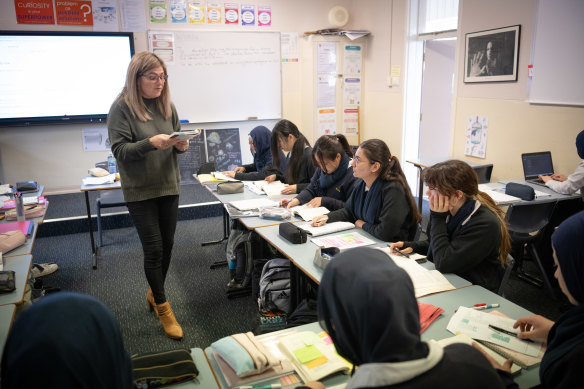Access the article here!
"We have a few secrets up our sleeves": The Sydney girls' school rising in the HSC charts
Written by Lucy Carroll and Nigel Gladstone
Published 14th of August, 2024 - 7:30pm
Veteran English teacher Kelly Andrews can pinpoint when she noticed a change in the reading and writing ability of her youngest high school students.
“A decade ago we realised there was a problem with reading comprehension - it was on the decline,” says Andrews, deputy principal at Birrong Girls High. “We knew we had to start teaching writing more explicitly, breaking down sentence and paragraph construction, step by step.”

Students in an English advanced class at Birrong Girls High with teacher Robyn Caravas. Credit: Wolter Peeters
The all-girls public school in Sydney’s south-west has since harnessed a fundamental shift in the way literacy and writing skills are taught in years 7 to 10, spreading that approach to other faculties.
“We do have a few secrets up our sleeve,” says Andrews, who has taught English for more than 30 years. Birrong Girls takes a forensic approach to analysing student data, she explains, while it has also raised the difficulty level of its assessments.
“We don’t dumb anything down. We expect really high things from our girls.”
A Herald analysis shows the school’s HSC English advanced score is consistently above 85, while its average score, when the mean of all subjects is taken, has risen to above 75.
The analysis of public schools’ HSC results shows girls’ fully selective and comprehensive schools outperform their boys’ counterparts when the mean of all subjects is taken, although that gap has narrowed slightly since 2019.
Band 6 results also show boys' schools across the sectors are also catching up to all-girls institutions. Data from 2022 shows girls are outperforming boys in most HSC courses, but boys’ schools maintain the lead in chemistry and the toughest maths courses.
Most co-ed schools improved results compared with 2019, with 169 schools recording improved average scores, while 145 went backwards.
Andrews says while Birrong Girls often scores below the state in NAPLAN in the first year of high school, by year 10 “we’re seeing that glimmer of improvement … and we rise to above the state average in year 11”.
“In the past five years, we’re getting students who are coming to us with even fewer skills. There are learning gaps so we’ve started including a specific literacy and numeracy period in year 7 and 8,” she says.
Andrews believes a fall in reading and writing has coincided with a rise in social media and more technology use. “That reading fluency has declined over time because kids aren’t getting the exposure to as many books.”

